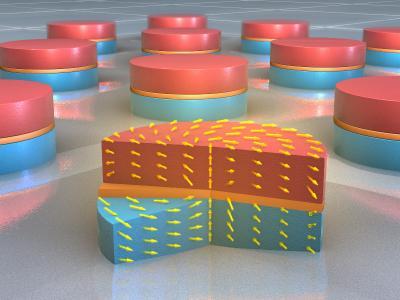"So far, magnetic vortex states have been observed only in two dimensions; in other words: Within a plane," explains Sebastian Wintz, physicist at the Helmholtz-Zentrum Dresden-Rossendorf. These magnetic vortices typically occur in nanometer-scale magnetic disks. Wintz has now investigated three-dimensional magnetic layer systems together with his colleagues from HZDR and the Swiss Paul Scherrer Institute: The researchers stacked two magnetic disks at a time, which were separated by a thin non magnetic metal layer, on top of each other. Due to this special design, all magnets surrounding the intermediate layer arrange themselves in equally oriented, three-dimensional vortices – an entirely new observation.
Magnetic vortices help researchers improve their fundamental understanding of magnetic materials. Yet they also offer very promising applications, for example, in information and communication technology. "Three-dimensional magnetic vortices could permit stable and high performance antennas for the ultrafast, wireless transmission of information, for example, in mobile communications or wi-fi," says Wintz. The reason is revealed by a more detailed look into a single magnetic disk as well as the magnetic layer system produced at the HZDR.
In a magnetic disk, all magnets are arranged in a circle – just as if individual bar magnets are placed one behind another. Even though the magnets do not move, scientists refer to them as magnetic vortices; they are, in fact, "static." In the center of the magnetic disks, the vortex core, the magnets can no longer arrange themselves in a circle; instead, they point out of the circle, either upward or downward. Such magnetic vortices are suitable as antennas for wireless data transmission: When connected to direct current, the vortex core starts moving in a circle. In doing so, it emits characteristic electromagnetic waves. If the speed is too high, though, the system will become instable, the magnetization direction will switch, and the radio wave is interrupted. The magnets in the vortex core now align in the opposite direction, once again start spinning, and emit new waves – until the speed gets too high again. Thus, a continuous data transmission is actually impossible.

Static, three-dimensional magnetic vortices are formed between two magnetic layers around a non-magnetic intermediate layer. These magnetic vortices stabilize the direction of magnetization in the center of the vortex core -- a prerequisite for stable vortex antennas for wireless data transmission.
(Photo Credit: HZDR/Sander Münster 3DKosmos)
This is different if two magnetic disks, separated by a thin non-magnetic metal layer, are stacked on top of each other. The structure is extremely thin; each magnetic disk is approx. only ten nanometers thick and has a diameter of about 500 nanometers. The intermediate layer may cause the magnets in each magnetic disk to not align precisely along the circle, but cause them to slightly incline either towards the vortex core or to the outside. The closer the magnets get to the metal layer, the more they also incline with respect to this barrier. And in such a way that all magnets – both above and below the intermediate layer – point in the same direction: The magnets form a static, three dimensional vortex around the metal layer between the core and the outer edge.
Since the innermost magnets are stacked almost vertically and the adjacent magnets always point in the same direction, the vertically positioned magnets in the vortex cores of two magnetic disks stacked on top of each other are always aligned parallely: They, thus, follow the direction of the 3D magnetic vortex. That is why it is no longer possible for the magnets to simply switch their direction. "The three-dimensional magnetic vortices stabilize the magnetization in the vortex core. That's why we suppose that magnetic layer systems such as those produced by us are better suited for vortex antennas than comparable single layers," summarizes Sebastian Wintz. The magnetic direction inside the vortex core is, thus, retained even at high rotation speeds. "It's conceivable to obtain frequencies of more than one gigahertz, which equals one billion cycles per second. For example, wifi networks work in this range," adds Wintz.
In order to produce magnetic disks with wafer-thin metallic intermediate layers, he took advantage of the HZDR's electron beam lithography. "We've used the rare metal rhodium and we've finally obtained the desired properties by modifying the thickness and roughness of the layers." The magnetic vortices were revealed at the Swiss Light Source (SLS), the synchrotron light facility of the Paul Scherrer Institute. Synchrotron light is a particularly intense form of light; its properties can be adjusted precisely to the individual requirements of an experiment. The work group headed by Jörg Raabe operates a scanning transmission X-ray microscope at the SLS which is able to directly display magnetization directions with a resolution of 20 nanometers as well as to separate the signals of two different magnetic materials from one another. Next, with the same method, the researchers want to examine the behavior of such magnetic disk pairs as high-frequency vortex antennas.